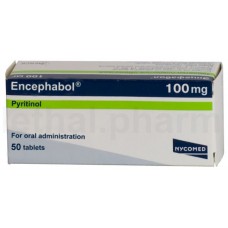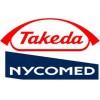Expiration date: 07/2026
Structure and Composition:
Film-coated tablets
1 tablet contains Pyritinol 100 mg dihydrochloride monohydrate
Excipients: 7000 carmellose sodium magnesium stearate colloidal silicon dioxide, sodium carboxymethyl cellulose, lactose monohydrate (powder)
Shell: dye quinoline yellow 70% glycolic mountain wax gelatin acacia wheat flour titanium dioxide, kaolin, talc (hydrous magnesium silicate), sucrose
in blisters of 10 pieces. or in dark glass bottles to 50 pcs. In the paper cartons 5 packages or 1 bottle.
Pharmachologic effect:
Pyritinol increases pathologically decreased metabolism in the brain by increasing the capture and utilization of glucose metabolism raises the nucleic acids and the release of acetylcholine in the synapses of the nerve cells, improve cholinergic transmission between nerve tissue cells. Pyritinol helps stabilize the cell membranes of nerve cells and their structure by inhibiting the function of lysosome enzymes, preventing the formation of these free radicals. Pyritinol improve blood rheology, plasticity of the erythrocytes increases by increasing their ATP content in the membrane, which leads to lower blood viscosity and improving blood flow. Pyritinol, improving blood circulation in the ischemic areas of the brain, increases their oxygen supply improves glucose metabolism in primary ischemic areas of the brain. As a result, improved memory performance and to restore the broken metabolism in nervous tissue that contributes to the full functioning of its cells.
Testimony:
- Symptomatic treatment of chronic disorders of the brain functions in dementia syndromes leading to the following symptoms: impaired memory, thinking and concentration ability, fatigue, lack of meaning and motivation, affective disorders.
- Primary degenerative dementia, vascular dementia and mixed forms.
- Symptomatic treatment of chronic disorders of mental capacity.
- Post-traumatic encephalopathy.
- Cerebral atherosclerosis.
- The consequences of encephalitis.
- Mental retardation, cerebroasthenic syndrome, encephalopathy in children.
Contraindications:
Absolute: Hypersensitivity to Pyritinol.
Relative: kidney disease, a history of marked disturbances of liver function, marked changes in peripheral blood, acute autoimmune diseases such as systemic lupus erythematosus, myasthenia gravis, pemphigus.
Application of pregnancy and breastfeeding:
Pyritinol crosses the placental barrier. Studies have not shown the presence of teratogenic or embryotoxic activity. The mother's milk enters a small amount Pyritinol. However, for reasons of principle, the decision to use the drug during pregnancy and breastfeeding should be made after careful weighing of the risk-benefit ratio.
Side effect:
When receiving encephabol in accordance with the indications and at the recommended doses, side effects should be expected.
Sometimes - hypersensitivity reactions of varying severity: skin rash or mucous membranes, itching, nausea, vomiting, diarrhea, fever, insomnia.
Rarely - increased irritability, loss of appetite, headache, dizziness, fatigue, change in taste, abnormal liver function (increased levels of transaminases, cholestasis).
Drug Interactions:
Increases side effects of penicillamine, sulfasalazine and gold products.
Dosage and administration:
Inside, during or after a meal, adults - 2 tablets. 3 times daily (600 mg per day), for children 7 years - Table 1-2. 1-3 times per day (100 to 600 mg per day depending on the indication).
When sleep disturbances last daily dose should not be taken in the evening or at night. The duration of treatment depends on the clinical picture of the disease: a significant therapeutic success is achieved after 3 to 4 weeks of treatment. Optimal and reliable effect is usually 6-12 weeks. The duration of treatment should be at least 8 weeks and may be continued if necessary.
Overdose:
Symptoms: increased side effects.
Treatment: gastric lavage, activated charcoal.
Special instructions:
Hypersensitivity reactions to the drug may occur in patients with hypersensitivity to the d-penicillamine, as the latter is similar to the chemical structure Pyritinol (thiol groups).




